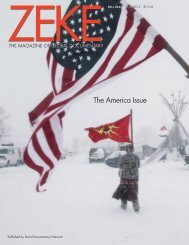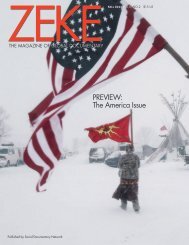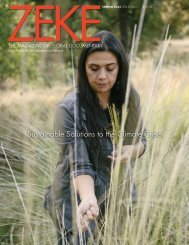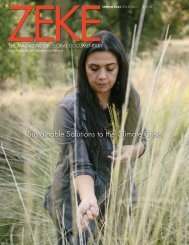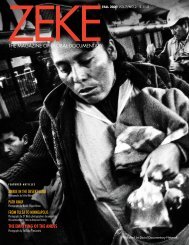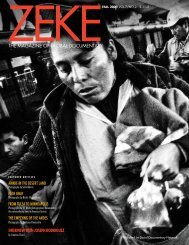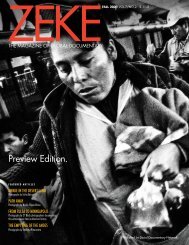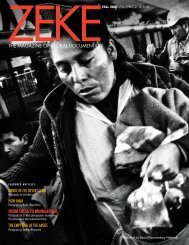ZEKE Fall 2019
Contents includes: "Youth of Belfast" by Toby Binder, and "Delta Hill Riders" by Rory Doyle, winners of ZEKE Award for Documentary Photography "Rising Tides" with photographs by Sean Gallagher, Lauren Owens Lambert, and Michael O. Snyder "Out of the Shadows: Shamed Teen Mothers of Rwanda" by Carol Allen Storey Interview with Lekgetho Makola, Head of Market Photo Workshop, South Africa, by Caterina Clerici "Why Good Pictures of Bad Things Matter" by Glenn Ruga Book Reviews and more...
Contents includes:
"Youth of Belfast" by Toby Binder, and "Delta Hill Riders" by Rory Doyle, winners of ZEKE Award for Documentary Photography
"Rising Tides" with photographs by Sean Gallagher, Lauren Owens Lambert, and Michael O. Snyder
"Out of the Shadows: Shamed Teen Mothers of Rwanda" by Carol Allen Storey
Interview with Lekgetho Makola, Head of Market Photo Workshop, South Africa, by Caterina Clerici
"Why Good Pictures of Bad Things Matter" by Glenn Ruga
Book Reviews and more...
- No tags were found...
Create successful ePaper yourself
Turn your PDF publications into a flip-book with our unique Google optimized e-Paper software.
Interview<br />
WITH LEKGETHO MAKOLA<br />
by Caterina Clerici<br />
Lekgetho Makola is the Head of Market<br />
Photo Workshop in Johannesburg, South<br />
Africa. He sits on the International Advisory<br />
Committee to the Board of CatchLight, and<br />
was on the Curatorial Advisory Committee<br />
of the 2017 Bamako Encounters. Over the<br />
past few years, he has been on the judging<br />
panels for various national and international<br />
photography and arts awards,<br />
including World Press Photo <strong>2019</strong>.<br />
Caterina Clerici: How did you get into<br />
photography?<br />
Lekgetho Makola: My background is<br />
fine arts, painting and sculpture but also<br />
multimedia and the theory of photography.<br />
I worked in museums in Durban, in<br />
post-apartheid South Africa, from 1999,<br />
supporting the collections and archival<br />
units. I also worked as a photographer for<br />
the museums, photographing the artworks<br />
for preservation but also documenting<br />
the events. I was also involved in curation.<br />
Three years later I moved to Cape<br />
Town where I started working as an<br />
exhibition manager at the Robben Island<br />
Museum. That’s where I began working<br />
with photographic archives but also<br />
documenting stories of people who had<br />
been imprisoned on Robben Island since<br />
the 1960s. So that’s when I started really<br />
working with the medium to tell stories.<br />
Later, I got awarded a Ford Foundation<br />
scholarship to go to Howard University<br />
in Washington, D.C. and do an MFA in<br />
Film Studies. I chose that because there<br />
is a lot more work done in film theory<br />
about black filmmaking, especially in the<br />
United States and South America. I think<br />
in those ten years I established my interest<br />
Patrick Selemani<br />
in images, focusing on activism around<br />
images, especially on the (African)<br />
Continent and in the context of post-colonial<br />
South Africa.<br />
CC: What motivated your interest in<br />
images?<br />
LM: Images are carriers of information, but<br />
also more than any other artistic practice,<br />
they reach a very wide audience and have<br />
the potential to impact perceptions. Images<br />
can become an integral part of education:<br />
carrying historic memories, but also helping<br />
people to think creatively or critically<br />
from a younger age. They also help us<br />
understand the context of our country, at a<br />
time when we are trying to find ourselves<br />
outside of the divisions of apartheid.<br />
CC: How did you end up at Market Photo<br />
Workshop?<br />
LM: After completing my studies at<br />
Howard University, I came to the Market<br />
Photo Workshop (MPW) because I had a<br />
very strong background in exhibitions, programming,<br />
and curating. I joined MPW as<br />
their Program and Projects Manager, overseeing<br />
the curriculum and creating synergy<br />
with the public programming side. When<br />
my predecessor, John Fleetwood, resigned<br />
four years ago I took over as the Head of<br />
the school. For me, the school is one of<br />
the most instrumental spaces for learning<br />
and teaching photography, and one that<br />
prioritizes its critical nature — photography<br />
for social change and advocacy. It<br />
aligned with what I’ve been doing since<br />
I completed my undergraduate studies in<br />
1994. I regard myself as an image activist:<br />
I’m thinking about the process of making<br />
an image, and the impact of that image in<br />
society.<br />
CC: What are the themes at the core of the<br />
School’s curriculum?<br />
LM: We believe that all the students who<br />
come into our space — usually 12 per educator<br />
— come in with a particular perspective<br />
or idea that inspires them, and our role<br />
is not to overload them with information,<br />
but to collaborate and bring the photographic<br />
resources and know-how for them<br />
to engage and better tell their own stories.<br />
During apartheid, photography focused<br />
on society and what was happening, documenting<br />
our lives collectively. Post-apartheid,<br />
people want to talk about themselves;<br />
self-reflection, the relationship with the<br />
environment they live in, their home, their<br />
livelihoods, issues of identity: “I’m black in<br />
post-apartheid South Africa. It’s a democracy.<br />
How does it relate to me?” They use<br />
images to explore those questions. One of<br />
the biggest outcomes from our space has<br />
been issues of representation on gender,<br />
sexuality, and non-conforming communities,<br />
and our space has now become what they<br />
regard as a safe space. The focus is on<br />
issues around transgender communities and<br />
acceptance, how people from these communities<br />
photograph themselves. Our public<br />
programming begins to create a platform<br />
for these kinds of discussions, using the<br />
students to lead them.<br />
CC: You mentioned images are also a tool<br />
for social change; have you seen photographic<br />
work translate into a change in the<br />
public’s perception of these issues?<br />
LM: Zanele Muholi (who joined MPW<br />
in 2000) shocked the classrooms and<br />
many male students. One of the issues she<br />
became interested in while in class was<br />
menstruation: she wanted to demystify this<br />
fear males have, but also to confront patriarchy,<br />
and through that process establish<br />
her own definition of gender and how she<br />
wants to be seen. Since then, not only has<br />
she created platforms for people to talk<br />
publicly about gender identity and sexuality,<br />
but she runs schools that help people<br />
from those communities find safe spaces—<br />
not only in South Africa but all over the<br />
world. That’s one example of something<br />
that started in our program but ended up<br />
being quite global. Lolo Veleko also had a<br />
huge impact on young photographers. She<br />
began teaching in the classroom about the<br />
relationship between fashion, space, and<br />
identity. We started seeing a lot of photographers<br />
borrowing from her style, and<br />
some of her work is now studied in relation<br />
to urban development and how to think of<br />
young people in urban settings.<br />
CC: Have you seen any new trends in the<br />
visual language that the new generations<br />
of artists have chosen to express themselves?<br />
LM: In the past three to four years, we’ve<br />
begun to see a change in the texture of<br />
images: people are much more experimental,<br />
they’re going beyond just photographing<br />
what’s happening around them; they’re<br />
52 / <strong>ZEKE</strong> FALL <strong>2019</strong>









